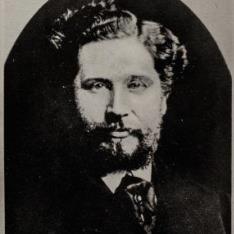
Biography
James Bell Pettigrew was born on 26 May 1832 in Lanarkshire to Robert Pettigrew and Mary Bell. His early education was in his hometown of Airdrie and at the University of Glasgow, where he studied arts from 1850 to 1855. Pettigrew moved to Edinburgh in 1856 where he began his medical studies. Pettigrew was intellectually brilliant and manually dexterous and established himself as an outstanding scholar in anatomy. In 1858 to 1859, Pettigrew was awarded a gold medal for the best treatise on anatomy. This treatise led Pettigrew to be appointed Croonian lecturer at the Royal Society of London in 1860. Pettigrew was awarded many medals for competitive essays in this period.
Pettigrew graduated MD from Edinburgh in 1861 and received a gold medal for his inaugural dissertation on ‘the ganglia and nerves of the heart and their connection with the cerebrospinal and sympathetic systems in Mammalia.’ Also in 1861, Pettigrew became House Surgeon to James Syme at the Royal Infirmary. In 1862, he was appointed assistant in the Hunterian Museum at the Royal College of Surgeons of England, a position he held until 1867. In 1867, Pettigrew became ill and was obliged to take a year of convalescence; however he continued to contribute dissections to the collection and wrote papers on various anatomical subjects. In this period also, Pettigrew experimented with artificial flight. Pettigrew continued his anatomical, physical and physiological researched, especially those on flight, and in 1870 published a memoir.
In 1872, Pettigrew contributed a course of lectures on physiology to the Edinburgh College Fellows. In 1875–7 he delivered special courses of lectures on physiology in Dundee, and University College, Dundee, owes its origin largely to his efforts. In 1877 he was elected by the universities of Glasgow and St Andrews to represent them on the General Medical Council. After 1886, when a new medical act enabled each of the Scottish universities to return its own member, Pettigrew represented St Andrews alone on the council. By 1889, when he gave the Edinburgh Harveian Oration, Pettigrew had become known internationally for his belief that, throughout the animal and plant kingdoms, at all orders of size, movements were often helical or spiral.
Pettigrew married in 1890 to Elsie, the second daughter of Sir William Gray, although the marriage was childless. Pettigrew spent the last ten years of his life working on Design in Nature, which was published posthumously. Around 1903, shortly before the Wright brothers made their first flights, Pettigrew secretly had his own petrol engine-driven aeroplane constructed. He flew it for 60 feet down a St Andrews street before it crashed, breaking his femur. He died in his home in St Andrews on 30 January 1908. A museum for the botanic gardens was erected in his memory by his widow as an adjunct to the Bute medical buildings of St Andrews University.
Notable Achievements
Pettigrew was elected fellow of the Royal Society in 1869.
In 1869, Pettigrew was appointed Pathologist at the Royal Infirmary in Edinburgh and curator of the museum of the Royal College of Surgeons of Edinburgh.
Pettigrew was elected fellow of both the Royal Society of Edinburgh and the College of Physicians of Edinburgh in 1873.
In 1874 he was awarded the Godard prize of the French Académie des Sciences for his anatomico-physiological researches and was made a laureate of the Institut de France.
In 1875 he was appointed Chandos professor of medicine and anatomy and dean of the medical faculty in the University of St Andrews.
In 1883 he received the honorary degree of LLD at Glasgow.
Key Publications
- ‘On the physiology of wings, being an analysis of the movements by which flight is produced in the insect, bird and bat’ (Transactions of the Royal Society of Edinburgh, 26) (1870)
- Animal Locomotion, or, Walking, Swimming, and Flying, with a Dissertation on aeronautics (1873)
- Design in Nature (1908)



